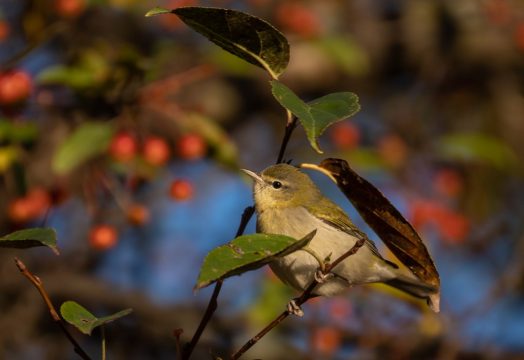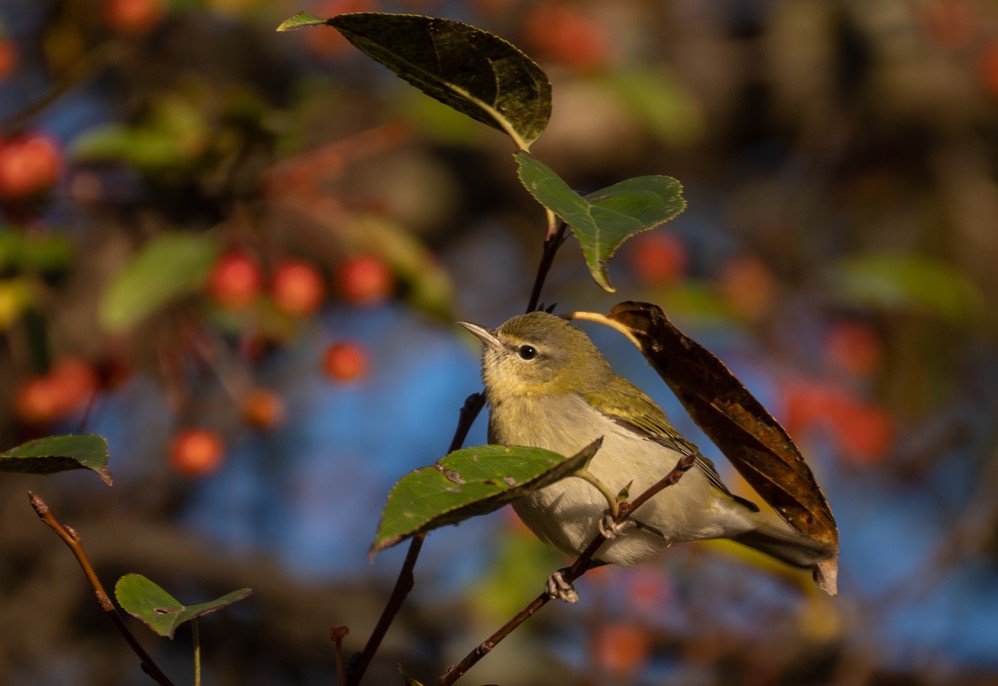Bird of the week: Tennessee Warbler
About: Tennessee Warblers are one of the drabber North American Warblers with gray undersides and an olive-green back with grayish wings. They breed across the boreal forests of Canada and migrate through much of the eastern US during migration. They feed primarily on small insects.
Where to find this bird: Tennessee Warblers tend to be found high in tree canopies where they like to flock with other warblers and songbirds. The best places to view them on campus are on the banks of the Fox River and Main Hall Green, where they will sometimes feed in smaller bushes.
When to find this bird: May and late August-early October
Fun fact: Even though they are named after the state of Tennessee, the closest breeding location is over 600 miles away in northern Michigan.

To bird – it’s a verb
When people ask me what I do in my free time, they are often surprised when I say I spend all my free time birding. When I say I spend all my free time birding, I really mean all of it. I’ve not missed a single day birding in over 5 years and spend well over 450 hours yearly looking for birds. But I’m not the only one who loves birds. In the U.S., more than 15 million people watch birds, and we birders put over $40 billion into the economy every year. Even though many birders carry around expensive binoculars, scopes and cameras, and travel regularly around the world to see different species, the cost to start birding is actually quite low. In fact, for most of my birding, I don’t use anything but my very own ears and stay within walking distance from my home. A pair of binoculars will be useful if you can get them and downloading a free bird ID app like Merlin on your phone will come in handy to get started. Birding can take many different forms, from watching birds at your backyard feeder to birding a single location year after year to observe changes in bird populations to flying across the country just to see a rare Eurasian goose species that has only ever been seen twice in the lower 48 states.
With over 10 thousand species of birds on earth and around 700 species found regularly in North America, birds are perfect to look for if you want to observe wildlife. They are highly adaptable and can be found on every continent and habitat on earth. This adaptability has created some truly astounding evolutionary feats: from the Peregrine Falcon, which can top 200 MPH, to the Bar-tailed Godwit, which flies non-stop from Alaska to New Zealand, to the Clark’s Nutcracker, which can remember thousands of stashed seed locations.
My obsession with birds started when I got my first camera at age 12. My best friend was into birding and I quickly found that birds were the easiest animals to photograph. From there my obsession just kept on growing and now I find myself thinking about birds constantly. I enjoy many different aspects of birding, from working long-term population trend studies to photographing birds to keeping a detailed list of all the birds I see each year. My obsession has led me to bird across the country and work with some of the leading birding organizations in the world. I love sharing my passion for birds and, as such, I will be sharing some insight into the world of birds and birding in this column each week. While we explore birds each week in this column, remember there are many ways to enjoy birds, so bird as you please!
Have questions for our resident birder? Ask them here!

